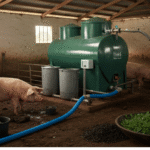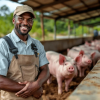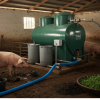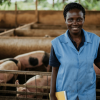Education costs continue rising in Uganda, placing quality schooling beyond reach for many families in rural areas. However, an innovative approach pioneered by HOG4Education demonstrates how pig farming can generate consistent income to fund educational advancement. This model has already helped over 50 families in Eastern Uganda transform agricultural profits into educational opportunities.
The Education Financing Challenge in Rural Uganda
Education costs in Uganda present significant barriers for rural families. Secondary school fees range from 200,000 to 800,000 UGX per term, while university education can cost 2-4 million UGX annually. For families earning less than 100,000 UGX monthly from subsistence farming, these amounts seem impossible.
Traditional education financing relies on savings, loans, or selling family assets – options that often prove inadequate or unsustainable. Many bright students abandon their education due to unpaid fees, perpetuating cycles of poverty and limiting community development.
Rural families need alternative income sources that generate consistent cash flow aligned with school fee payment schedules. Agriculture, properly managed, can provide this solution.
Why Pig Farming Works for Education Financing
Pig farming offers unique advantages for education funding that align perfectly with academic calendars and family financial needs:
Predictable Income Cycles: Pigs reach market weight every 6-8 months, providing regular income that matches school term schedules. Families can plan sales to coincide with fee payment deadlines.
Scalable Investment: Families can start small and reinvest profits to expand operations. As children progress through school requiring higher fees, farming income can grow proportionally.
Manageable Operations: Pig farming requires less labor than crop farming, allowing students to participate in family businesses while continuing their studies.
Quick Returns: Unlike long-term investments, pig farming generates income within the first year, providing immediate relief for families facing education costs.
Minimal Land Requirements: Families don’t need extensive land holdings to establish profitable pig farming operations, making this strategy accessible to most rural households.
HOG4Education’s Education Financing Model
HOG4Education has developed a comprehensive approach that specifically targets education funding through pig farming. The model includes several key components:
Tailored Training Programs: Families receive training focused on generating education-specific income, including financial planning, savings strategies, and business growth planning.
Starter Package Support: Families receive quality piglets, initial feed supplies, and veterinary care to ensure successful launch of their operations.
Education Savings Planning: Participants learn to budget farming income specifically for education costs, creating dedicated savings accounts and financial management systems.
Academic Year Alignment: Production cycles are planned to align with school fee payment schedules, ensuring income availability when families need it most.
Long-term Growth Planning: As children advance through different education levels, farming operations expand to meet increasing financial requirements.
Community Support Networks: Families connect with others using similar strategies, sharing knowledge and providing mutual support during challenging periods.
Case Study: The Otim Family’s Educational Transformation
John and Mary Otim faced a devastating choice in early 2024: sell their small plot of land to pay their daughter’s secondary school fees or watch her abandon her education. With three children and dreams of university education for all, they needed a sustainable solution.
HOG4Education’s education financing program provided the answer. John and Mary joined intensive training focused specifically on generating education income through pig farming.
Initial Investment and Setup (March 2024):
- Started with 4 piglets provided through the program
- Built proper housing with community volunteer labor
- Learned feed formulation using local ingredients
- Established education savings account specifically for school fees
First Results (August 2024):
- First pig sales generated 720,000 UGX profit
- Paid daughter’s second-term fees with money remaining for expansion
- Purchased 3 additional piglets with sale profits
- Daughter’s grades improved significantly with reduced stress about fees
Continued Growth (December 2024):
- Second sales cycle generated 1.1 million UGX
- Paid both daughter’s third-term fees and son’s primary school requirements
- Expanded operation to 8 breeding pigs
- Started saving for daughter’s university education
Current Status (January 2025):
- Farm maintains 12 pigs with regular breeding cycle
- Monthly income averaging 800,000 UGX from pig sales
- All three children’s current school fees secured
- University savings fund growing steadily
“We went from crisis to confidence in less than a year,” Mary explains. “Now we plan our children’s education knowing we can afford it. Our daughter wants to become a veterinarian, and we’re saving for her university fees.”
The Otim family now mentors other families in their community, showing them how agriculture can fund educational dreams.
Financial Planning for Education-Focused Pig Farming
Successful education financing through pig farming requires careful financial planning and management. HOG4Education teaches families specific strategies:
Education Cost Assessment:
- Calculate total education costs for all children through university
- Factor in annual fee increases and inflation
- Include costs for books, uniforms, transportation, and living expenses
- Plan for unexpected educational opportunities or requirements
Income Projection and Planning:
- Estimate pig farming income based on breeding schedules and market prices
- Plan production cycles to align with fee payment deadlines
- Factor in operational costs including feed, veterinary care, and labor
- Build contingency funds for health emergencies or market fluctuations
Savings and Investment Strategy:
- Establish dedicated education savings accounts
- Reinvest portion of profits to expand farming operations
- Balance current education needs with long-term university savings
- Diversify income sources as operations grow
Risk Management:
- Maintain proper pig health to minimize mortality losses
- Develop relationships with multiple buyers to ensure market access
- Keep emergency funds for unexpected veterinary or operational costs
- Consider insurance options for valuable breeding stock
Success Metrics and Community Impact
HOG4Education’s education financing model has produced measurable results across participating communities:
Student Retention Rates: Children in participating families show 95% school retention rates compared to 67% regional average for families facing fee challenges.
Academic Performance: Students from education-focused pig farming families achieve average grades 18% higher than peers, likely due to reduced financial stress and family stability.
Long-term Educational Achievement: 78% of children from participating families complete secondary education compared to 45% regional average.
University Access: 34% of graduates from participating families pursue university education, nearly three times the regional average of 12%.
Community Development: Villages with multiple participating families show increased overall education levels, improved health outcomes, and greater economic stability.
Overcoming Common Challenges
Families pursuing education financing through pig farming face predictable challenges that HOG4Education helps address:
Initial Capital Requirements: The program provides starter packages and teaches families to begin with minimal investment, reinvesting profits for growth.
Technical Knowledge Gaps: Comprehensive training ensures families have necessary skills for successful pig management and health care.
Market Access Concerns: HOG4Education’s buyer network guarantees market access, ensuring families can convert pigs to education funding when needed.
Balancing School and Farm Work: Training emphasizes time management and age-appropriate involvement of children in farming activities that support rather than interfere with education.
Seasonal Income Variations: Families learn to manage breeding cycles and savings to ensure consistent income aligned with education costs.
Integration with Formal Education Systems
HOG4Education works closely with local schools and educational institutions to maximize the impact of education financing through agriculture:
School Partnership Programs: Schools receive training to identify students facing fee challenges and refer families to HOG4Education’s programs.
Academic Support Integration: The program provides study materials and tutoring support funded through farming profits, ensuring children maximize their educational opportunities.
Career Guidance and Planning: Students learn about agricultural careers and business opportunities, potentially continuing family farming enterprises while pursuing higher education.
Community Education Events: Schools host events where successful families share their stories, inspiring others to pursue education financing through agriculture.
Long-term Vision and Sustainability
HOG4Education’s education financing model creates sustainable cycles of improvement that benefit entire communities:
Generational Impact: Children who receive education through family pig farming often return to their communities with enhanced skills, contributing to local development.
Knowledge Transfer: Educated children often introduce improved farming techniques, veterinary care, and business practices to family operations.
Community Leadership: University graduates from participating families frequently become teachers, health workers, and local leaders, multiplying the program’s impact.
Economic Development: Communities with higher education levels attract better services, infrastructure improvements, and economic opportunities.
Getting Started with Education-Focused Pig Farming
Families interested in financing education through pig farming can begin immediately with HOG4Education’s proven approach:
Assessment and Planning: Meet with HOG4Education trainers to assess your family’s education goals, current resources, and development needs.
Comprehensive Training: Complete intensive training covering pig farming techniques, business management, and education-specific financial planning.
Starter Package and Setup: Receive quality piglets, initial supplies, and setup support to launch your education financing operation.
Ongoing Support and Mentorship: Access continued veterinary care, market connections, and business development support throughout your journey.
Community Network Participation: Connect with other families pursuing similar goals for mutual support, knowledge sharing, and collaborative problem-solving.
Investment in Your Family’s Future
Education financing through pig farming represents more than just an alternative income source – it’s an investment in your family’s future and your community’s development. Families who participate in HOG4Education’s program don’t just pay school fees; they build sustainable businesses that continue generating income long after children complete their education.
Contact HOG4Education at +256787498143 or visit our training center in Kumi Municipality to learn how pig farming can fund your children’s educational dreams. Join the growing number of families transforming agricultural income into educational opportunity.
Your children’s future starts with the decision to act today. Make education affordable and agriculture profitable through HOG4Education’s proven education financing model.
Learn more about successful families and our comprehensive training programs in our other blog posts. Follow HOG4Education for regular updates on education success stories and new opportunities.









